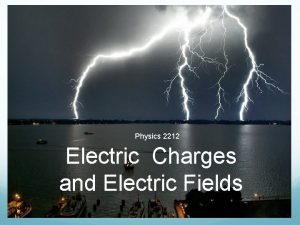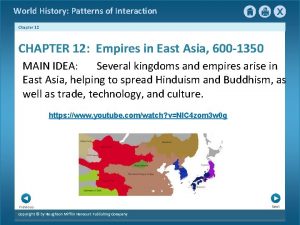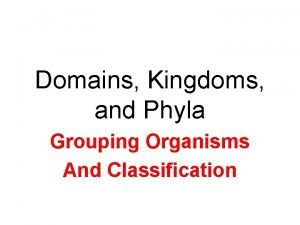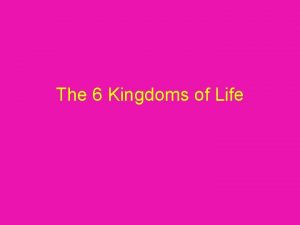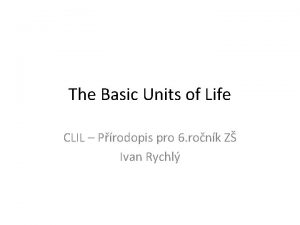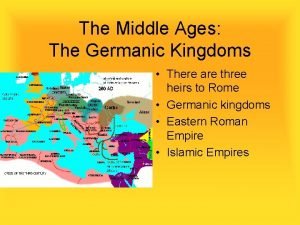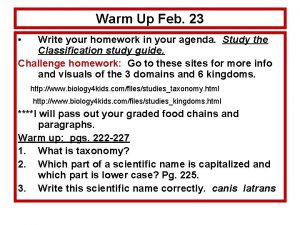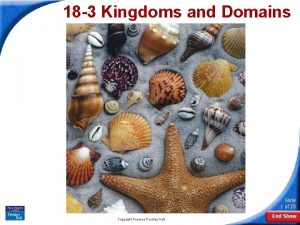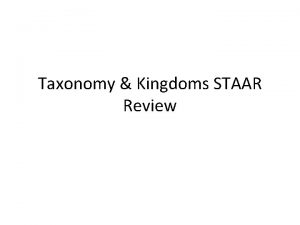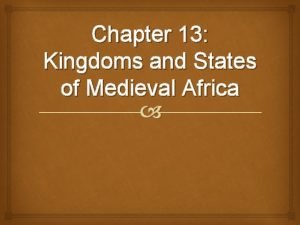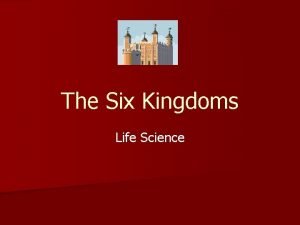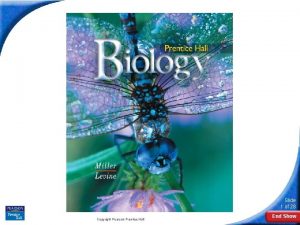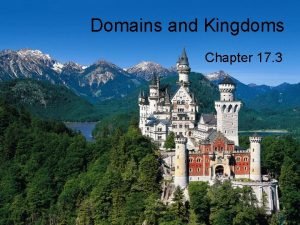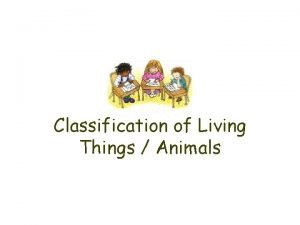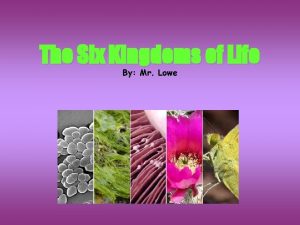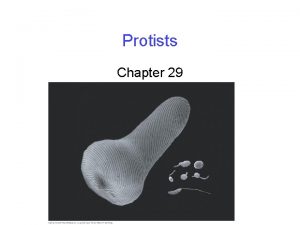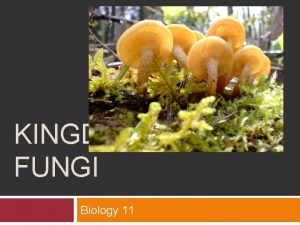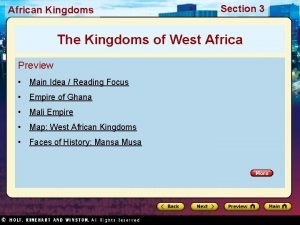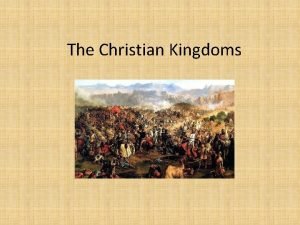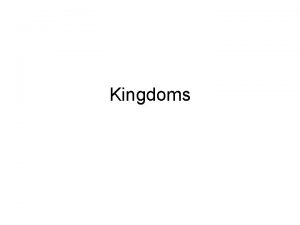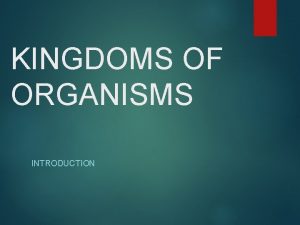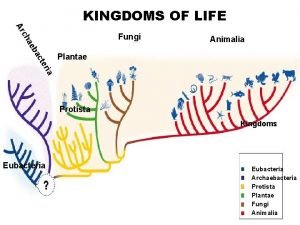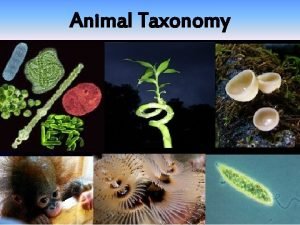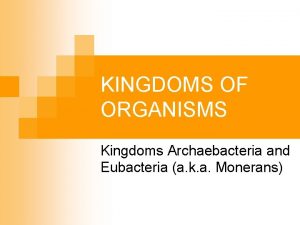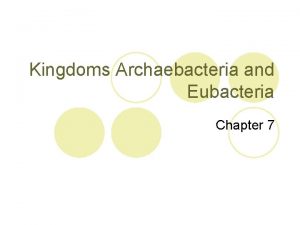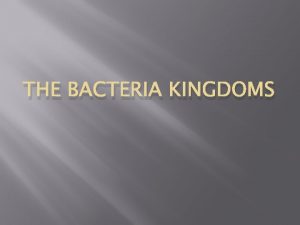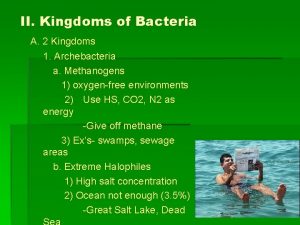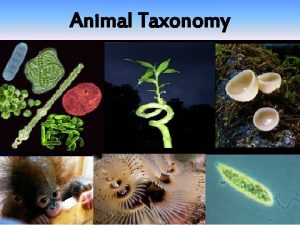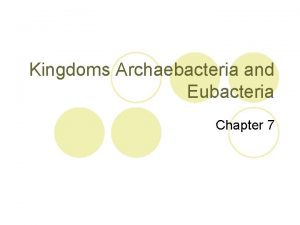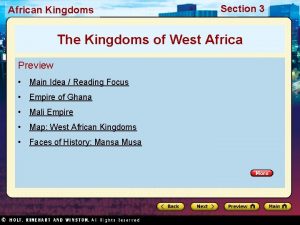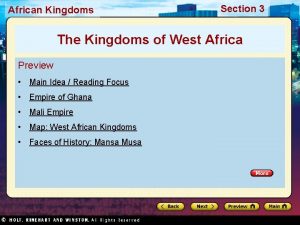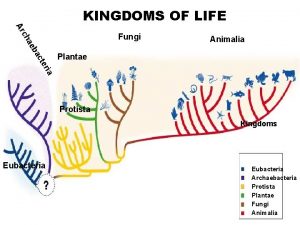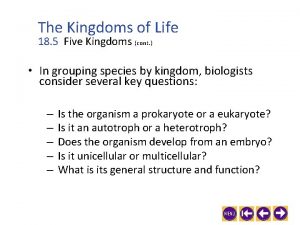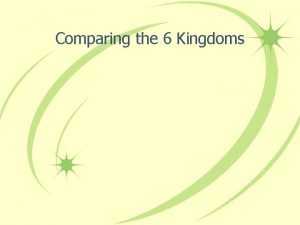Take 5 2212 What are the 6 kingdoms









































































- Slides: 73

Take 5 (2/2/12) What are the 6 kingdoms of life? Archeabacteria, Eubacteria, Protists, Fungi, Plants and Animals Can protists be both unicellular and multicellular? Yes!! Fun fact: Giardia lamblia causes nonbacterial diarrhea. Infection is commonly by contaminated water supply.

Take 5 (2/3/12) What are the 3 ways that protozoans can move? Cilia, flagella, pseudopodia What is a spore? A reproductive cell that forms without fertilization and produces a new organism Are all protozoans are ______ and unicellular are _____. heterotrophs

Take 5 (2/9/10) What is phagocytosis? How does an amoeba move? What is the function of the contractile vacuole? __________________ Agenda: 1. Take 5 2. Kingdom Protist Lab-turn in and pick up HW

Take 5 (2/10/10) Algae is a ________ protist. Photosynthesizing unicelluar protists are known as _______. phytoplankton Multicellular algae looks like plants _____.

Take 5 (2/11/10) What are we looking at today under the microscope? What kingdom are they from? What are the 2 types?

Take 5 (1/25/11) Many protozoans are classified according to ______________. The way they move The plantlike protists that are the cause of red tides are ________. dinoflagellates The plantlike protists with delicate shells that make up a large proportion of the phytoplankton in freshwater ecosystems are ______. diatoms

Take 5: 2/13/12 The air bladders of brown algae allow float near the water’s surface for the algae to _______. photosynthesis Amoebas form extensions of their plasma membranes to move and feed. pseudopodia These extensions are called ________ Which structure controls daily life functions in the paramecium? Macronucleus

Take 5: 2/9/12 A protozoan that moves by moving oar-like Ciliate hairs back and forth is a(n) _______. Resemble fungi, Downy mildews and water molds are decompose matter, and similar to fungi in that they both absorb nutrients _________. Flagella A Euglena moves by means of

Take 5: 2/8/12 Green Algae _________ is the most diverse algae that lives in freshwater, on tree trunks, or on the fur of sloths. A type of reproduction that occurs when an individual breaks up into pieces, each of which grows into a new individual is called Fragmentation ______________. The fungus-like protists that produce a multinucleate glob of cytoplasm are the Plasmodial ____. Slime Molds

Take 5 (2/6/12) What is a protozoan? Name the 4 An animal-like protist. Amoeba, Ciliate, groups. Flagellate, and Sporozoan. What is algae? A plant-like protist. What type of protozoan is Plasmodium, and what does it cause? It is a sporozoan-it causes the disease Malaria.

Take 5: 2/7/12 Which phylum of algae is composed only of unicellular species? Euglena, Diatoms, Dinoflagellates Excess water is pumped out of a paramecium by means of its Contractile Vacuole ___________ Euglena is unusual among both the protists and other organisms because it Plant-like Animal-like is both ______ and _______.

Chapter 19 Protists

The World of Protists SECTION 1

I. What is a Protist? Kingdom _____ contains the most Protista diverse organisms of all the kingdoms. ◦ May be _____ or multicellular, microscopic or unicellula very _____, heterotrophic or autotrophic. large r ◦ The characteristic that ____ protists share is all they are all ______, eukaryotic ◦ The animal-like protists are called ______, Protoza unlike animals, though, all protozoans are (protozoans) _______. unicellular ◦ The plant-like protists are called _____, unlike algae plants; algae do not have organs such as roots, _____, and leaves. stems

I. What is a Protist? ◦ Still other protists are like fungi because they ______, but are able to move decompose _____ and do not have chitin in their cell walls. ◦ Unicellular algae produce much of the oxygen ______ in the Earth’s atmosphere aquatic and are the basis of _____ food chains.

II. What is a protozoan? All protozoans are unicellular ______ that heterotroph feed on other s organisms or dead ______ organic matter The usually reproduce asexually ______.

III. Diversity of Protozoans Many protozoans are grouped according to the way they ____. move EX: cilia, ______, pseudopodia flagella • Pseudopodia (“false foot”) = cytoplasm -containing ______ of the extensions plasma membrane. • There are ____ main groups of four protozoans: _____, flagellates, amoebas ______, sporozoans. ciliates

III. Diversity of Protozoans Amoebas: Shape-less protists – (phylum Rhizopoda) • Amoebas have no cell ____ and form wall pseudopodia to move and ______. feed • Two groupings of mostly _____ amoebas marine A. 1. Foraminifera – abundant on the sea floor, have hard ______ made of calcium carbonate. shells 2. Radiolarian – are important part of marine plankton- an assortment of microscopic organisms ______ that float in the _____ and ocean form the base of marine food chains. * Most amoebas reproduce ________. asexually


Actinophrys clip

Most amoebas reproduce via asexual reproduction ◦ Single parent produces offspring by dividing into two cells Amoebas can also form cysts to protect itself if conditions are unfavorable Asexual Reproduction

III. Diversity of Protozoans Flagellates: Protozoans with flagella – (phylum Zoomastigina) * Some flagellates are ________ parasites B. that cause diseases, other are helpful to other organisms, such as the flagellates that _____ in the gut of live __________. termites

Trypanosoma gambiense Some are parasites & cause disease (i. e. African sleeping sickness) personality change weight loss irritability loss of concentration progressive confusion slurred speech seizures difficulty walking and talking sleeping for long periods of the day insomnia at night

III. Diversity of Protozoans Ciliates: Protozoans with cilia (phylum Ciliophora) • Use ______ that cover their bodies to cilia C. • • move. Live in every kind of ______ habitat. aquatic Many ______ found in ciliates’ cells may structures work together to perform just _______ one important life functions. EX: a paramecium uses it’s _____, oral groove, cilia _____, and food vacuoles in the process of gullet digestion.

Ex: Paramecium uses its cilia, oral groove, gullet, and food vacuoles in the process of digestion

III. Diversity of Protozoans ◦ A paramecium usually reproduces ______ by dividing crosswise and asexually separating into _____ daughter two cells. environment ◦ When ______ conditions change, al they usually undergo a form of conjugation.

III. Diversity of Protozoans Sporozoans: Parasitic protozoans (phylum Sporozoa) • Most produce ________. spores • Spores = is a ______ cell that forms reproductive D. • • without fertilization and produces a new ______. organism All sprozoans are parasites, have complex ________. Life cycles Plasmodium, are organisms that cause the disease _____ in humans and other malaria mammals and in _______. birds

spore Adult sporozoans have no structures for movement

III. Diversity of Protozoans E. • Sporozoans and malaria Today, more than ____ million people 300 have malaria, which usually occurs in _____ climates. tropical • The Plasmodium that ______ mosquitoes transmit to people cause human malaria. • Today, a combination of drugs chloroquine and _____ are most often used to treat primaquin emalaria. • Some species of Plasmodium have begun to _____ these drugs. resist

The general symptoms include: • headache • nausea • fever • vomiting and • flu-like symptoms

http: //www. youtube. com/watch? v=IVbq 2 y. QH 52 g

Algae: Plant-like Protists SECTION 19. 2

I. What are algae? Photosynthesizing ________ protists are called algae. All algae contain up to four kinds of chlorophyll that can produce a variety of colors in algae: _____, rusty-red, purple olive-brown, and golden-brown, and are a way of classifying algae. Algae include both unicellular and multicellular _____ organisms.

What are algae? Photosynthesizing protists! Have up to 4 kinds of chlorophyll ◦ Colors = purple, rusty-red, olive-brown, yellow and golden-brown

I. What are algae? Photosynthesizing unicellular protists are known as ______ which phytoplankton produce much of the _____ used oxygen on Earth. plants Although multicellular algae may look like _____, they have no roots, leaves stems or ______.


What eats phytoplankton? Zooplankton

II. Diversity of Algae _____ are classified in six phyla Algae Three of these phyla-include only unicellular species ◦ Euglenoids ◦ ______ diatoms ◦ Dinoflagellates Most species in other three phyla are ______. multicellular ◦ Green ◦ ______ red ◦ brown

II. Diversity of Algae A. • • Euglenoids: Autotrophs Euglenoids are unicellular, ______ aquatic protists that have both plant and Animal _____ characteristics. They _____ a cell wall made of lack cellulose Most have chlorophyll and photosynthesize, but when light is not ingest available, they can _____ food. flagella They have one or more _____ to move.

II. Diversity of Algae B. • • • Diatoms: The golden Algae Unicellular photosynthetic protists with shells composed of ____. silica The make up a large component of the _______ population. phytoplankton The ______ that diatoms make food is stored as ______ rather than oils starch, which help them to ______ near the surface where float ______ is available. light

II. Diversity of Algae ◦ Diatoms reproduce ______ for several asexually generations before reproducing sexually. ◦ Diatom shells are mined, processed, and used as abrasives in tooth and metal ______, or added to polishes _____ to give it sparkle. paint

II. Diversity of Algae Dinoflagellates: The spinning algae • Cell _____ composed of thick cellulose walls C. • • plates. Have _____ flagella located in grooves two at right angles to each other, the cell spins ____ slowly as they beat. Major component of ________. phytoplankton Some are bioluminescent, which means they emit ______. light Some produce _____, which cause red toxins ______. tides

Dinoflagellates: the spinning algae Some are bioluminescent free-living species

Red Tide

II. Diversity of Algae D. • • Red Algae Mostly multicelluar marine ______. seaweeds The body of a seaweed is called a thallus, and lacks _____, stems, or ____. roots leaves Red algae use structures called _____ holdfasts to attach to rocks. They contain photosynthetic _____ pigments called phycobilins, which can absorb the light that is able to penetrate water below _____ meters, allowing read algae to 100 live in deep water.

Red algae Sushi is made with a red alga known as Nori or Porphyra.

II. Diversity of Algae Brown Algae • Most live in _______ water along rocky salt coasts in ____ areas. cool • May have __________ that keep Air bladders E. • their bodies floating near the surface, where light is available. The largest and most complex of brown algae are ______. kelp

Brown algae Have air bladders help buoyancy (to stay near the LIGHT)

Brown algae Largest, most complex brown algae = kelp ◦ Thallus is divided into holdfast, stripe, and blade ◦ Grow 60 m ◦ Cali coasts ◦ Giant dense underwater forests

II. Diversity of Algae F. • • • Green Algae The most diverse, with more than 7000 ____ species. Most live in freshwater, in moist soil _____, on tree trunks, in snow, and even in the ______ of sloths. fur Can be unicellular, colonial, or multicellular ______ in organization. EX: Chlamydomonas (unicellular), spirogyra ( multicellular), Volvox (colony)

Green algae and sloths

Green Algae * A way of reproducing asexually is through fragmentation, where an individual breaks up into pieces and each piece grows into a new individual.

II. Diversity of Algae ◦ Green algae can reproduce both asexually and _____. sexually ◦ A way of reproducing asexually is through _____, where an individual breaks fragmentation up into _____ and each piece grows pieces into a new individual. ◦ Green algae have complex life cycle, which consists of individuals that alternate between producing _____ and spores producing gametes.

Green algae Reproduce sexually and asexually Spirogyra reproduces asexually via fragmentation ◦ An individual breaks up into pieces and each piece grows into a new individual

III. Alternation of Generations The life cycles of some of the algae _____ and all ______ have a plants + pattern called alternation of generations _____. An organism that has this pattern haploid alternates between existing as a diploid ____ and ____ organism. The haploid form of the organism is called the gametophyte because it gametes produces ______.

III. Alternation of Generations The gametes fuse to form a _______ zygote from which the diploid forms of the organism, which is called the ______. sporophyte Certain cells in the sporophyte undergo _____, eventually; meiosis these cells become haploid spores that can develop into a ______ new gametophyte.


Alternation of Generations

Red tide and hatching Turtles

Slime Molds, Water Molds, and Downy Mildews SECTION 19. 3

I. What are funguslike protists? These protists ______ organic decompose materials. Slime molds have characteristics of both protozoans and fungi and are classified by reproduce the way they ______.

What are funguslike protists? Ex: slime molds, water molds, downy mildews http: //www. youtube. com/watch? v=CIEgg. UBoiv. Y “looks like dog vomit” Heterotrophic organisms that decompose organic material

A. • • I. What are funguslike protists? Slime Molds They live in ____, moist, shady places cool where they grow on _____, organic damp matter, such as rotting ____ or decaying leaves tree stumps. Two major types of slime molds: ____ plasmodial slime molds and _____ slime molds. cellular Slime molds are _______-like during much of animal their life, moving about and engulfing food _______ in a way similar to that of amoebas. Like fungi, slime molds make _____ to spores reproduce.

1) Slime molds Beautiful colors Live in cool, moist, & shady habitats Grow on rotting leaves or decaying logs

I. What are funguslike protists? B. • • • Plasmoldial slime molds The get their name from the fact they form a plasmodium, a mass of _____ that cytoplasm contains many diploid nuclei but no cell walls or _______. membranes The slimy mass is the ____ stage of the feeding organism, and same move at the rate of 2. 5 cm per ____. hour When _____ becomes scarce, it food transforms itself into spore-producing structures. Meiosis take place and produces ____ haploid spores which will turn into ____ what will gametes fuse together forming a zygote. This will grow

Plasmodial Slime Mold

I. What are funguslike protists? C. Cellular Slime Molds • • • Unlike plasmodial slime molds, cellular slime molds spend part of their life cycle as an ______ independent cell. When food is scarce, these independent cells _______ with join hundreds of others to _______. reproduce Cellular slime molds are haploid during their ____ life cycle. entire

B) Cellular slime molds

B) Cellular slime molds = haploid during entire life

II. Water Molds and Downy Mildews http: //www. youtube. com/watch? v=7 zf. WRPWehl. E&feature=related Live in ______ or moist places. water Some feed on dead organisms and others are ____ parasites. plant Most water molds appear _____, fuzzy and resemble fungi, but at some point water mold produce flagellated reproductive _____, something cells fungi never do.

2) Water molds & downy mildews Produce flagellated reproductive cells (This is the reason why they are called protists and not grouped with fungi) http: //www. youtube. com/watch? v=Poy 9 Nt. Mtg 0 o

2) Water molds & downy mildews Ex: downy mildew that causes disease in many plants ◦ Phytophthora infestans ◦ Destroy potatoes

III. Origin of Protists There is little conclusive _____ evidence to indicate whether ancient protists were the evolutionary ancestors of fungi, plants _______, and animals or whether protists ____ emerged as evolutionary lines that were separate. Some biologists agree that ancient _______ were probably Green algae ancestral to modern ______. plants
 Insidan region jh
Insidan region jh Physics 2212
Physics 2212 Cs 2212
Cs 2212 Take a bus or take a train
Take a bus or take a train Thế nào là hệ số cao nhất
Thế nào là hệ số cao nhất Diễn thế sinh thái là
Diễn thế sinh thái là Vẽ hình chiếu vuông góc của vật thể sau
Vẽ hình chiếu vuông góc của vật thể sau Frameset trong html5
Frameset trong html5 Làm thế nào để 102-1=99
Làm thế nào để 102-1=99 Lời thề hippocrates
Lời thề hippocrates Tư thế worm breton là gì
Tư thế worm breton là gì đại từ thay thế
đại từ thay thế Vẽ hình chiếu đứng bằng cạnh của vật thể
Vẽ hình chiếu đứng bằng cạnh của vật thể Quá trình desamine hóa có thể tạo ra
Quá trình desamine hóa có thể tạo ra Thế nào là mạng điện lắp đặt kiểu nổi
Thế nào là mạng điện lắp đặt kiểu nổi Khi nào hổ con có thể sống độc lập
Khi nào hổ con có thể sống độc lập Các châu lục và đại dương trên thế giới
Các châu lục và đại dương trên thế giới Dot
Dot Nguyên nhân của sự mỏi cơ sinh 8
Nguyên nhân của sự mỏi cơ sinh 8 Bổ thể
Bổ thể Phản ứng thế ankan
Phản ứng thế ankan Thiếu nhi thế giới liên hoan
Thiếu nhi thế giới liên hoan Alleluia hat len nguoi oi
Alleluia hat len nguoi oi điện thế nghỉ
điện thế nghỉ Tia chieu sa te
Tia chieu sa te Một số thể thơ truyền thống
Một số thể thơ truyền thống Trời xanh đây là của chúng ta thể thơ
Trời xanh đây là của chúng ta thể thơ Hệ hô hấp
Hệ hô hấp Công thức tiính động năng
Công thức tiính động năng Số nguyên tố là số gì
Số nguyên tố là số gì đặc điểm cơ thể của người tối cổ
đặc điểm cơ thể của người tối cổ Tỉ lệ cơ thể trẻ em
Tỉ lệ cơ thể trẻ em Các châu lục và đại dương trên thế giới
Các châu lục và đại dương trên thế giới ưu thế lai là gì
ưu thế lai là gì Môn thể thao bắt đầu bằng chữ f
Môn thể thao bắt đầu bằng chữ f Tư thế ngồi viết
Tư thế ngồi viết Bàn tay mà dây bẩn
Bàn tay mà dây bẩn Hình ảnh bộ gõ cơ thể búng tay
Hình ảnh bộ gõ cơ thể búng tay Mật thư anh em như thể tay chân
Mật thư anh em như thể tay chân Từ ngữ thể hiện lòng nhân hậu
Từ ngữ thể hiện lòng nhân hậu Tư thế ngồi viết
Tư thế ngồi viết Thẻ vin
Thẻ vin Thế nào là giọng cùng tên? *
Thế nào là giọng cùng tên? * Chó sói
Chó sói Thể thơ truyền thống
Thể thơ truyền thống Sự nuôi và dạy con của hổ
Sự nuôi và dạy con của hổ Kingdoms of archaea
Kingdoms of archaea Chapter 12 section 5 kingdoms of southeast asia and korea
Chapter 12 section 5 kingdoms of southeast asia and korea What kingdom is archaea in
What kingdom is archaea in Cladogram of 6 kingdoms
Cladogram of 6 kingdoms Keys and kingdoms
Keys and kingdoms The six kingdoms
The six kingdoms Five kingdoms of living things
Five kingdoms of living things Germanic kingdom
Germanic kingdom Flow chart of domains and kingdoms
Flow chart of domains and kingdoms Section 18-3 kingdoms and domains
Section 18-3 kingdoms and domains Crash course taxonomy
Crash course taxonomy Seven pernicious kingdoms
Seven pernicious kingdoms Chapter 13 kingdoms and states of medieval africa
Chapter 13 kingdoms and states of medieval africa What are the two kingdoms of bacteria
What are the two kingdoms of bacteria Two domains composed of only unicellular organisms are
Two domains composed of only unicellular organisms are Biology kingdom chart
Biology kingdom chart The hellenistic kingdoms
The hellenistic kingdoms Chapter 13 kingdoms and states of medieval africa
Chapter 13 kingdoms and states of medieval africa Archaebacteria body type
Archaebacteria body type Israel divided into two kingdoms
Israel divided into two kingdoms 18-3 kingdoms and domains
18-3 kingdoms and domains Bacteria is found in which of the 6 kingdoms
Bacteria is found in which of the 6 kingdoms Chapter 17 domains and kingdoms
Chapter 17 domains and kingdoms I am covered in dry scales and i lay eggs. what am i?
I am covered in dry scales and i lay eggs. what am i? What are the six kingdoms of life?
What are the six kingdoms of life? Paramecium cladogram
Paramecium cladogram Stramenopila
Stramenopila 11 kingdoms
11 kingdoms

